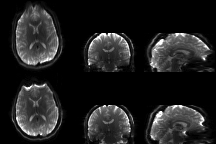Summary of what happened:
I am trying to use dcm2bids to convert some DICOMs to NIFTI format before running fmriprep. For the EPI scans, the protocol states Sagittal R >> L, Coronal A >> P, Transversal F >> H (or I >> S), and Phase Encoding Direction A >> P. Therefore, I believe the .nii file should be LPS orientation and the json file should have “PhaseEncodingDirection”: “j”
For the field maps, Sagittal R >> L, Coronal A >> P, Transversal F >> H and Phase Encoding Direction R >> L. So, should be “PhaseEncodingDirection”: “i”
However, after running dcm2bids, I get LAS as the EPI orientation and j as the pe direction, and i- as the pe direction for the field maps. I’m not sure why this is, but I’m thinking perhaps because we’re using a tilted acquisition, it’s confusing dcm2bids’ method for determining orientation. When I view the image in AFNI it seems like it’s LPS (i.e. coordinates are positive in left, posterior and superior regions), however after some reading I think this may be the way AFNI visualizes all images, is that right?
When I then run fMRIPrep, it tells me the orientation is LAS and phase encoding direction is Posterior-Anterior, but the distortion correction looks ok.
Command used (and if a helper script was used, a link to the helper script or the command generated):
dcm2bids: dcm2bids -d ${raw_dir}/${subj}/${ses}/DICOMs -p "${subj}" -s "${ses}" -c ${config_dir}/bids-config_${subj}_${ses}.json --forceDcm2niix
with config file as follows:
{
"descriptions": [
{
"dataType": "anat",
"modalityLabel": "T1w",
"criteria": {
"SeriesNumber": 10
}
},
{
"dataType": "fmap",
"modalityLabel": "magnitude1",
"intendedFor": [
3,
4,
5],
"criteria": {
"SeriesNumber": 4,
"EchoTime": 0.01
}
},
{
"dataType": "fmap",
"modalityLabel": "phasediff",
"intendedFor": [
3,
4,
5],
"criteria": {
"SeriesNumber": 5,
"EchoTime": 0.01476
}
},
{
"dataType": "func",
"modalityLabel": "bold",
"customLabels": "task-affvis",
"criteria": {
"SeriesNumber": 6
},
"sidecarChanges": {
"TaskName": "affvis"
}
},
{
"dataType": "func",
"modalityLabel": "bold",
"customLabels": "task-facegender",
"criteria": {
"SeriesNumber": 8
},
"sidecarChanges": {
"TaskName": "facegender"
}
},
{
"dataType": "func",
"modalityLabel": "bold",
"customLabels": "task-facememory",
"criteria": {
"SeriesNumber": 2
},
"sidecarChanges": {
"TaskName": "facememory"
}
}
]
}
Version:
dcm2bids v2.1.9
Environment (Docker, Singularity, custom installation):
Conda
Please let me know if there’s any other information that might be useful! I feel like I may be missing something important.
